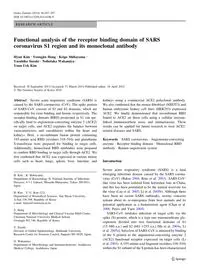
2014 Functional analysis of the receptor binding domain of SARS coronavirus S1 region and its monoclonal antibody PDF
Preview 2014 Functional analysis of the receptor binding domain of SARS coronavirus S1 region and its monoclonal antibody
RESEARCH ARTICLE Functional analysis of the receptor binding domain of SARS coronavirus S1 region and its monoclonal antibody Hyun Kim • Yeongjin Hong • Keigo Shibayama • Yasuhiko Suzuki • Nobutaka Wakamiya • Youn Uck Kim Received: 30 September 2013 / Accepted: 31 March 2014 / Published online: 16 April 2014 � The Genetics Society of Korea 2014 Abstract Severe acute respiratory syndrome (SARS) is caused by the SARS coronavirus (CoV). The spike protein of SARS-CoV consists of S1 and S2 domains, which are responsible for virus binding and fusion, respectively. The receptor-binding domain (RBD) positioned in S1 can spe- cifically bind to angiotensin-converting enzyme 2 (ACE2) on target cells, and ACE2 regulates the balance between vasoconstrictors and vasodilators within the heart and kidneys. Here, a recombinant fusion protein containing 193-amino acid RBD (residues 318–510) and glutathione S-transferase were prepared for binding to target cells. Additionally, monoclonal RBD antibodies were prepared to confirm RBD binding to target cells through ACE2. We first confirmed that ACE2 was expressed in various mouse cells such as heart, lungs, spleen, liver, intestine, and kidneys using a commercial ACE2 polyclonal antibody. We also confirmed that the mouse fibroblast (NIH3T3) and human embryonic kidney cell lines (HEK293) expressed ACE2. We finally demonstrated that recombinant RBD bound to ACE2 on these cells using a cellular enzyme- linked immunosorbent assay and immunoassay. These results can be applied for future research to treat ACE2- related diseases and SARS. Keywords SARS coronavirus � Angiotensin-converting enzyme � Receptor binding domain � Monoclonal RBD antibody � Rennin–angiotensin system Introduction Severe acute respiratory syndrome (SARS) is a fatal emerging infectious disease caused by the SARS corona- virus (CoV) (Baker 2004; Rota et al. 2003). SARS-CoV- like virus has been isolated from horseshoe bats in China, and this has been postulated to be the natural reservoir for the virus (Lau et al. 2005; Li et al. 2005b). Although there have been no recent SARS outbreaks, serious concerns remain about its re-emergence from host animals and its potential application as a bioterrorism agent (Chan et al. 2006; Peiris and Yuen 2004). SARS-CoV mediates infection of target cells via the spike (S) protein, which is a type one transmembrane gly- coprotein divided into two functional domains of S1 (15–680 a.a.) and S2 (681–1255 a.a.) (He et al. 2004a; Li et al. 2005a). Infection of SARS-CoV is initiated by binding of the S protein to the angiotensin-converting enzyme 2 (ACE2) functional receptor expressed on target cells (Li et al. 2003). A 193-amino acid fragment (residues 318–510) within the S1 subunit of the S protein has been characterized H. Kim � K. Shibayama Department of Bacteriology II, National Institute of Infectious Diseases, 4-7-1 Gakuen, Musashi-Murayama, Tokyo 208-0011, Japan H. Kim � Y. U. Kim (&) Department of Biomedical Sciences, Sun Moon University, A-San 336-708, Republic of Korea e-mail:
